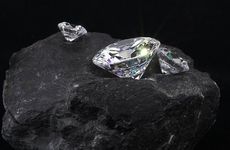
Greg Ponesse — March 28, 2006 — Luxury
References: moneycentral.msn
Most people are all too familiar with having champagne tastes on a beer budget. But when it comes to diamonds, you may be able to have it both ways.
That's because gem-quality diamonds are now being grown in laboratories in places like Sarasota, Fla., and Boston. Forget cubic zirconia and Moissanite, which are made to pass as diamonds. Lab-grown stones are the real deal. And instead of the millions of years it takes to create natural diamonds, they're grown by man in a matter of days.
"We've essentially recreated the same conditions that occur hundreds of miles below the surface," says David Hellier, president of Gemesis, the Florida company that specializes in growing colored diamonds. "After about four and a half days, we get a three-carat rough diamond. From that day forward, there's no difference between that diamond and one that comes from the ground."
That's because gem-quality diamonds are now being grown in laboratories in places like Sarasota, Fla., and Boston. Forget cubic zirconia and Moissanite, which are made to pass as diamonds. Lab-grown stones are the real deal. And instead of the millions of years it takes to create natural diamonds, they're grown by man in a matter of days.
"We've essentially recreated the same conditions that occur hundreds of miles below the surface," says David Hellier, president of Gemesis, the Florida company that specializes in growing colored diamonds. "After about four and a half days, we get a three-carat rough diamond. From that day forward, there's no difference between that diamond and one that comes from the ground."
Trend Themes
1. Lab-grown Diamonds - Disruptive innovation opportunity: The lab-grown diamond industry has the potential to disrupt the natural diamond market, providing a more affordable and ethically sourced alternative.
2. Shortened Diamond Production - Disruptive innovation opportunity: By reducing the time it takes to grow diamonds from millions of years to just a few days, the lab-grown diamond industry disrupts traditional diamond production methods.
3. Gem-quality Technology - Disruptive innovation opportunity: The advancement of gem-quality lab-grown diamonds offers new possibilities for industries such as jewelry, fashion, and luxury goods.
Industry Implications
1. Jewelry - Disruptive innovation opportunity: The lab-grown diamond industry can disrupt the traditional jewelry industry by providing a more affordable and sustainable option for consumers.
2. Mining - Disruptive innovation opportunity: The rise of lab-grown diamonds presents a disruption to the traditional diamond mining industry, with potential implications for job markets and resource allocation.
3. Fashion - Disruptive innovation opportunity: The introduction of lab-grown diamonds can create innovative and sustainable fashion designs, offering new possibilities for brands and designers.
5.6
Score
Popularity
Activity
Freshness























